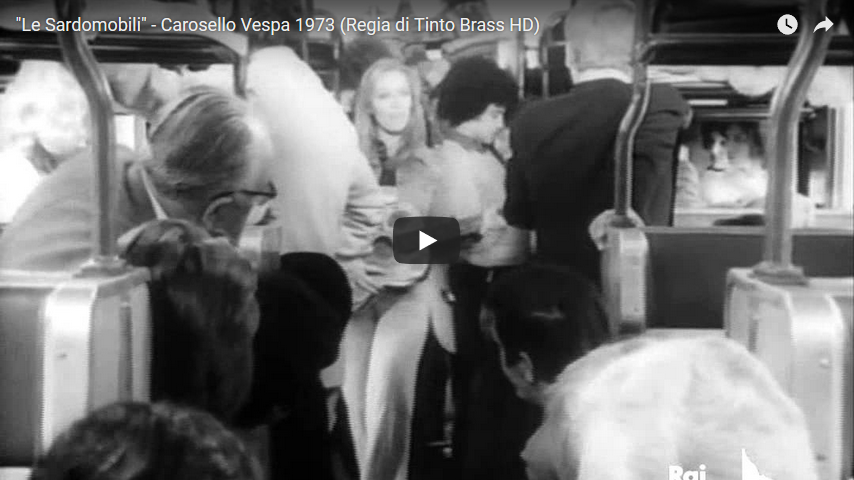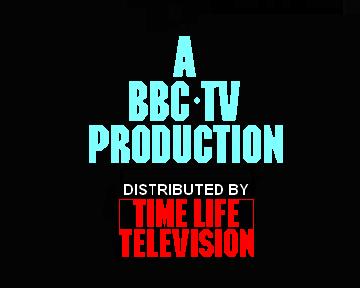THE WORKS OF TINTO BRASS
Le sardomobili
(The Sardine-Mobiles, 1972? 1973?)
In the midst of abandoned movie
projects, Brass directed this TV commerical for
Piaggio advertising the Vespa motorscooter. I think
it was one of a series of three concurrent
commercials.

And lo and behold! Look what my friend Aldo De Luca sent me: A link to the commercial!
https://www.youtube.com/watch?v=LbWhdLL5j1Q
but, of course, it was taken down by command of RAI.
Why RAI? Why? What income were you losing by allowing this antique commercial to be seen again?
Phooey! Okay, somebody reloaded it on DailyMotion,
but the sound is out of sync, noticeably behind the image.
NON INTRALCIATE LE USCITE | DON’T BLOCK THE EXITS |
LASCIATE LIBERO IL PASSAGGIO | LEAVE THE PASSAGEWAY FREE |
SECONDA CLASSE | SECOND CLASS |
POSTO RISERVATO | RESERVED SEATING |
le sardomobili respirano grigio | the sardine-mobiles breathe grey |
Amico, se vuoi scrivere una ballata sull’arcobaleno, non usare l’inchiostro nero. | Friend, if you want to write a ballad on the rainbow, don’t use black ink. |
Non c’è nero nel arcobaleno. | There’s no black in the rainbow. |
Rosso, giallo, verde, viola, | Red, yellow, green, purple, |
Rosso, giallo, verde, viola, | Red, yellow, green, purple, |
Rosso, giallo, verde, viola, blu. | Red, yellow, green, purple, blue. |
Scrivi verde colle foglie, | Write green with leaves, |
Scrivi rosso colle rose, | Write red with roses, |
Scrivi blu col acqua fresca di sorgenti blu. | Write blue with blue springs’ fresh water. |
C’È POSTO PER TUTTI | THERE’S SEATING FOR EVERYONE |
NESSUNO CLASSE | ANYBODY’S CLASS |
Rosso, giallo, verde, viola, blu. | Red, yellow, green, purple, blue. |
Amico, se vuoi scrivere una ballata per cantare a colore, non usare l’inchiostro nero. | Friend, if you want to write a ballad to sing about color, don’t use black ink. |
Non c’è nero nel arcobaleno. | There’s no black in the rainbow. |
Scrivi giallo con il grano. | Write yellow with corn, |
Scrivi arancio col tramonto. | Write orange with the sunset. |
Scrivi blu con gli occhi limpidi di una ragazza in più. | Write blue with the clear eyes of yet one more girl. |
USCITE CON NOI | EXIT WITH US |
Rosso, giallo, verde, viola, | Red, yellow, green, purple, |
Rosso, giallo, verde, viola, | Red, yellow, green, purple, |
Rosso, giallo, verde, viola, blu. | Red, yellow, green, purple, blue. |
Splende chi Vespa. | Those who Vespa sparkle. |
Scrivi rosso colle rose, | Write red with roses, |
Scrivi blu col acqua fresca di sorgenti blu. | Write blue with blue springs’ fresh water. |
Rosso, giallo, verde, viola, blu. | Red, yellow, green, purple, blue. |
PIAGGIO cambia il mondo in due ruote. | PIAGGIO, changing the world on two wheels. |
Here, in two minutes, is a template of Tinto’s style.
First of all, there’s great casting for faces.
The two greatest when it came to casting for faces were Tinto Brass and Federico Fellini.
Even if you can’t understand their Italian dialogue,
you can gaze at those evocative faces that they chose.
We have more, too: half-obscured images and words,
obscured faces, camera movements forcing our imaginations to piece together larger pictures,
off-centered camera work, impressionistic editing (some undercranking at the beginning too, I think).
There’s also fearlessness about revealing messes.
Other filmmakers like clean, uncluttered frames, showing only what they want to show, and as clearly as possible.
Tinto realizes that life is messy, and so he shows messes, a jumble, and leaves it up to us what to focus on.
The rebellion against rules and constraints is here too, blatantly.
Freedom: people bursting out as themselves, breaking free of a rut.
The combination of image and sound is startlingly complex.
You might not believe me on a first viewing. Watch it ten more times.
The edits bind feelings together, subtly, subliminally.
As with Laurel & Hardy’s better movies, there is total contempt here for continuity.
We also have a moment of crude animation.
Animation is another ingredient that Tinto needs but has never been able to afford.
Unfortunately, here I think it was pre-existing and included per contract.
Nonetheless, it provides just the right touch.
Now, look what else is added: A ballad!
In only two other Tinto works were there ballads.
Those were, of course, Dropout and La vacanza, as I’m sure you remember.
Yet in Dropout the ballad was pasted over two interludes, and in La vacanza it was pasted over the end credits.
In this commercial it’s integral, and it is this use of the ballad that his remaining works cry out for.
Better than that: wistfulness.
In some of his movies we get nostalgia. In some we get fairy tales.
One of his best movies, The Key, is so plaintive it hurts.
But here we have wistfulness. That’s another quality that his other works cry out for.
And that’s all in addition to four unidentified performers who are, in my opinion,
the most beautiful women who ever appeared in front of Tinto’s cameras.
(Does anybody know who they are?)
By the way, that’s not the blonde’s voice and she’s faking the guitar.
Actually, this was shot mute.
The song was prerecorded and the others sounds were added in later.
All the signs are props. The real signs are hidden behind them.
Bizarre, though, that at the end the women ride in the back.
I thought Tinto would have reversed that typical rôle play, but he didn’t.
That was probably a concession to the advertiser, who in turn conceded to RAI.
The funny thing about this commercial is that it’s essentially saying,
“You want to rebel against society?
You can do so only by purchasing our motorscooters.
You want to be a hippie?
Then you need to purchase our motorscooters, or else you’ll never be a hippie.
You want to throw off consumerism?
Then you better buy our motorscooters.
You want to deface a railroad car?
Deface the cheap props instead, and just make it look like you’re defacing the railroad car.”
Well, it’s a commercial. What do you expect?
Now, imagine you’re a film editor
who’s just been handed the 30 minutes of raw footage that went into producing this commercial.
Would you be able to figure out how to piece it together?
If so, you’re a mindreader.
This is the sort of filmmaking that only the director can edit together.
No one else need apply.
|


